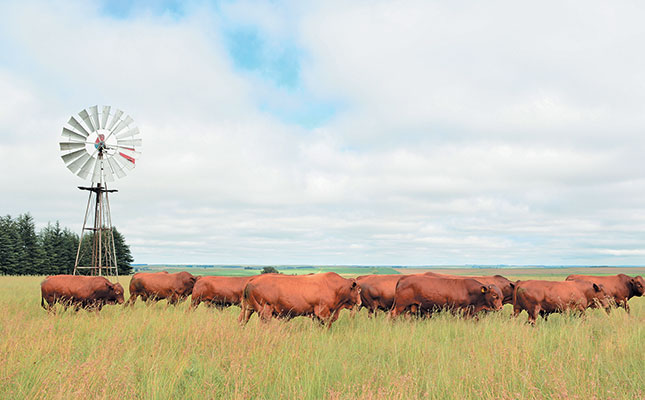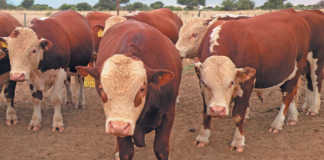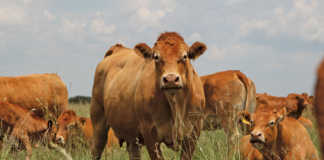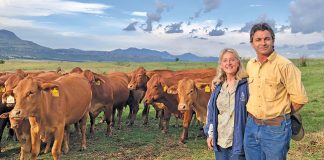
Photo: FW Archive
It’s safe to say that stud breeders everywhere would rush to use any method designed to take the guesswork out of determining an animal’s genetic merit or breeding value. Such a system would save a considerable amount of time, effort and money, and make a significant difference to the bottom line.
Now SA Stud Book claims that it has access to just such a method, thanks to a “brilliant development” in the field of genomics, says SA Stud Book CEO, Dr Japie van der Westhuizen.
The Single Step method replaces the expensive Two Step method of determining genomically enhanced breeding values (GEBVs), and allows for more accurate best linear unbiased prediction (BLUP) values.
The basics
Put simply, a gene is a discrete segment of DNA, located at a specific site (locus) on a specific chromosome pair.
Two copies of each gene exist in each nucleated diploid cell in an animal.
The unique nucleotide sequence of each gene determines its specific biological role.
However, because genes occur in pairs (alleles) in body cells, one gene of a pair may have one effect, and the other gene may have a different effect on the same trait.
According to Van der Westhuizen, each bull or cow possesses a code of approximately three billion base pairs on the 60 chromosomes in the nucleus of each body cell (except sex cells, which consist of half the number of chromosomes each).
Genomics strive to record the complete genetic code of an organism by determining
the entire sequence and structure of an organism’s DNA (its genome), and then working out how that DNA is arranged into genes.
A relatively new discipline, genomics is important to livestock farmers because they need to know how different genetic codes will affect an animal’s performance. Genes, of course, influence appearance, reproduction, mothering ability, growth rate and efficiency, condition score, survival, and meat and carcass quality.
Currently, the BLUP method provides the most precise genetic evaluations possible, depending on the quality of the information available about pedigree and performance, relative to contemporaries subjected to exactly the same environmental constraints.
The breeder also needs to know the proportion of the performance caused by transferable genetic differences, which is where the problems start.
Where a single gene has a marked influence, a laboratory test is usually developed to determine its locus on the chromosome.
“But,” says Van der Westhuizen, “most traits or properties of economic importance are influenced by a multitude of genes, called additive genes, on different chromosomes.”
As mentioned, each gene can present different forms (alleles) that either enhance or thwart the expression of the trait and, therefore, the performance of the animal.
A further complication is that these traits are also influenced by environmental factors. This makes it next to impossible to detect and determine the exact effect of each additive gene, and hence the true genetic merit or breeding value of an animal.
The genetic merit of an animal becomes clearer if a specific trait has been recorded and the breeder has the trait records of its parents. Accuracy is further increased if records exist for large numbers of progeny, as each shares 50% of its parents’ genetic code.
Put another way, it’s possible to estimate genetic merit to a certain extent even if the exact genetic code causing the performance differences among the progeny remains unknown.
Too young
Sometimes, however, animals are too young for traits such as longevity or female fertility to be recorded. Determining BLUP breeding values in such cases involves apportioning a breeding value based on the most likely allocation of the genetic code.
A progeny’s predicted genetic merit will be halfway between those of the parents (mid-parent value). But even in the case of full siblings, the progeny from two parents can differ substantially, and any errors in mid-parent allocation will become apparent only once the animal or its progeny is measured.
Get it wrong, and a great deal of time would have been wasted.
To address these challenges, geneticists started to investigate possible relationships between parts of an animal’s genome and a specific animal’s breeding value, which brings one back to genomics.
Genomic tests reveal that there are between 7 000 and as many as 700 000 base pair codes in the entire genome.
Initially, the focus was on testing as many animals as possible with highly accurate breeding values for their genomic information.
“The objective was to establish the effect of a series of genomic code or base pairs on the breeding values for the traits,” explains Van der Westhuizen.
To increase the accuracy of calculating these effects, thousands of animals are needed as a ‘reference population’, especially for traits of lower heritability and where BLUP breeding values are unavailable. Initially, the minimum was set at 1 000 animals, but this was increased to tens of thousands to boost accuracy.
With the effects known, the genetic merit of young animals can be unlocked. But to do this successfully, the parents’ average BLUP breeding values, as well as the animal’s genomic profile, are needed.
Where only the genomic profile is known, one ends up with direct genomic values (DGVs).
Without a proper BLUP parent average, one’s ability to predict heritability is limited.
Correctly combining the BLUP parent average and DGVs produces a genomically enhanced breeding value (GEBV).
Known as the Two Step method, this still calls for large reference populations and is very expensive. By contrast, SA Stud Book’s Single Step method simply uses the true relationship among animals obtained from genomic information, instead of assumed relationships based on pedigree alone.
Thus, all guesswork due to the randomness of inheritance is eliminated. Once the true relationships among animals with known genotypes are taken into account, ‘normal’ BLUP breeding values are calculated.
Advantages
The greatest advantage of the Single Step method is the reduction of low accuracy in BLUP breeding values. A trait such as milk (maternal ability) BLUP breeding values in beef cattle is a good example.
“Typically, a two- to three-year-old bull will be offered for sale at an auction,” explains Van 2017der Westhuizen.
“The BLUP breeding value for milk will then be based on a mid-parent value [the average of the sire and dam] simply because no measurement can take place on the bull and neither were any of the weaning weights of its daughters’ calves recorded.”
Should a genomic profile of such a young bull be available, the accuracy of the BLUP breeding value prediction would be equal to that of a six-year-old bull with between five and 10 recorded weaned calves from its daughters.
Depending on the bull’s true relationship to other bulls, and recorded feed intake, the accuracy of prediction for feed efficiency will also drastically increase. An added bonus is that it removes parentage guesswork in cases where the genomic profiles are known.
The present genomic tests available to SA Stud Book make use of a database of 50 000 markers (base pairs) confirming exact parentage.
“The Single Step method is a giant leap for the accurate prediction of genetic merit in potential selection candidates,” says Van der Westhuizen.
“The risk of choosing the wrong herd sire is greatly reduced. This can change an expensive decision into the most profitable one.”
The Single Step method has already been applied to two SA Stud Book breeds: the Bonsmara and Beefmaster. They will be followed by the Drakensberger next year. Plans to apply the technology to SA dairy cattle breeds are also underway.
Phone Dr Japie van der Westhuizen on 083 253 4745, or email him at [email protected]











